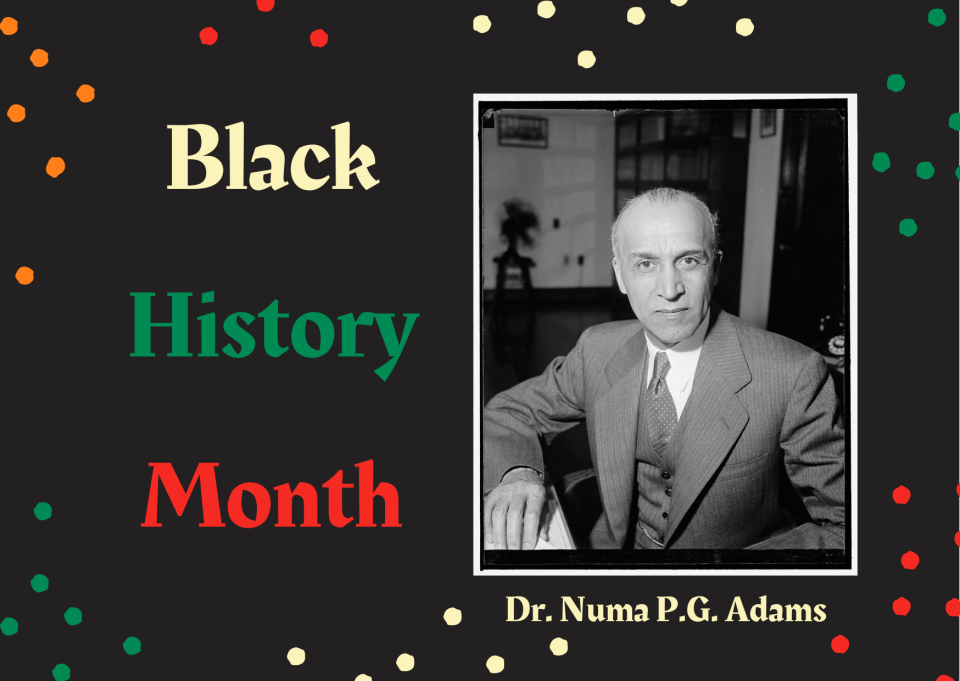
In honor of Black History Month, Himmelfarb Library celebrates the life of Dr. Numa Pompilius Garfield Adams, the first Black Dean of Howard University’s College of Medicine. Numa P.G. Adams was born in 1885 in Delaplane, Virginia, about 55 miles west of Washington, D.C. His grandmother, Mrs. Amanda Adams, an important figure in Adams’ life, was a respected midwife who assisted in delivering hundreds of babies (Cobb, 1951). According to a 1951 article in the Journal of the National Medical Association, Adams’ grandmother “inspired the beginning of his scientific curiosity” through her “vast knowledge of medicinal herbs” (Cobb, 1951).
At age 13, Adams’ family moved to Steelton, Pennsylvania. Adams bought a second-hand cornet in Pennsylvania and learned to play (AAREG, n.d.). This musical ability would serve him well later in life when he played in bands to earn the money that would pay his way through college and medical school (Cobb, 1951). Adams attended public school in Pennsylvania and graduated high school with honors in 1905 (Cobb, 1951). After high school, he spent a year working as a substitute teacher in Steelton, followed by a year teaching seventh grade in Carlisle, Pennsylvania (Cobb, 1951).
In 1911, Adams received a bachelor’s degree from Howard University and earned a master’s degree in chemistry from Columbia University in 1912 (Cobb, 1951). Adams served as an instructor, assistant professor, and associate professor of chemistry at Howard University from 1912-1919, and as the head of the Department of Chemistry from 1918 to 1919 (Cobb, 1951). Adams left Howard University to begin medical school at Rush Medical College in the Spring of 1920 and received an M.D. after completing an internship at St. Louis City Hospital No. 2 in 1924 (Cobb, 1951).
In 1929, Adams became the first Black dean of Howard University College of Medicine, a role he would have until he died in 1940 (Lloyd, 2006). He is largely remembered for his fervent recruitment of young faculty members, specifically young Black faculty. Through funding from the General Education Board, Adams was able to send these young Black faculty members for “two years of advanced training at prestigious universities and hospitals around the country” (Lloyd, 2006). Dr. Charles Drew was among the faculty members Adams recruited into this program. During his final years as Dean, Adams was instrumental in integrating Howard University and Freedman’s Hospital (AAREG, n.d).
Adams also continued to work on projects outside of the medical school. Adams was active in numerous professional organizations. He served as Chairman of the Commission on Medical Education and was a member of the Advisory Committee on the Legislation of the National Medical Association for the Advancement of Science, the American Hygiene Society, and the National Tuberculosis Association just to name a few (Maloney, 1940).
Adams was a staunch supporter of medical libraries, and when he was shown plans for the Homer G. Phillips Hospital in St. Louis, “he quietly pointed out that he saw no provision for a library and a first-class hospital must have a good library” (Cobb, 1951). Adams even published a piece in the Journal of the National Medical Association titled “Medical Libraries in Approved Hospitals for Negroes” in 1938. In this article, he states:
“No investment of hospital funds will produce bigger or better income than that made in the blossoming and maintenance of an adequate medical library. For an approved hospital the provision of such a library is an obligation.” (Adams, 1938)
Adams died on August 29, 1940, at Billings Hospital in Chicago, Illinois. Maloney said of Adams in a published memorial that Adams was a “builder of brains” and the “builder and conservator of health” (Maloney, 1940). Adams was highly thought of by those who knew him, including Dr. Robert A. Lambert, former Associate Medical Director of The Rockefeller Foundation. Lambert stated that his “estimate of Dr. Adams may be summarily expressed in the designation man of wisdom, fine sensibility, clear judgment, patient determination, and courageous action” (Cobb, 1951). Dr. Joseph L. Johnson, former Dean of Howard University School of Medicine stated that “to know Numa Adams was to respect, to admire, and to love him. He was of a brilliant mind and was always the quiet, unassuming, soft-spoken gentleman. One could never know of his greatness from his lips” (Cobby, 1951).
References:
Adams N. P. (1938). Medical Libraries in Approved Hospitals for Negroes. Journal of the National Medical Association, 30(2), 49–53.
African American Registry (AAREG). (n.d.). Numa P.G. Adams, doctor, and educator born. AAREG Stories. https://aaregistry.org/story/numa-p-g-adams-born/
Cobb, W.M. (1951). Numa P. G. Adams, M.D., 1885-1940. Journal of the National Medical Association, 43(1), 42–54.
Lloyd, Jr., S.M. (Last updated May 2006). History. Howard University College of Medicine. https://medicine.howard.edu/about/history
Maloney A. H. (1940). In Memoriam: Numa Pompilius Garfield Adams. Journal of the National Medical Association, 32(6), 257–258.



